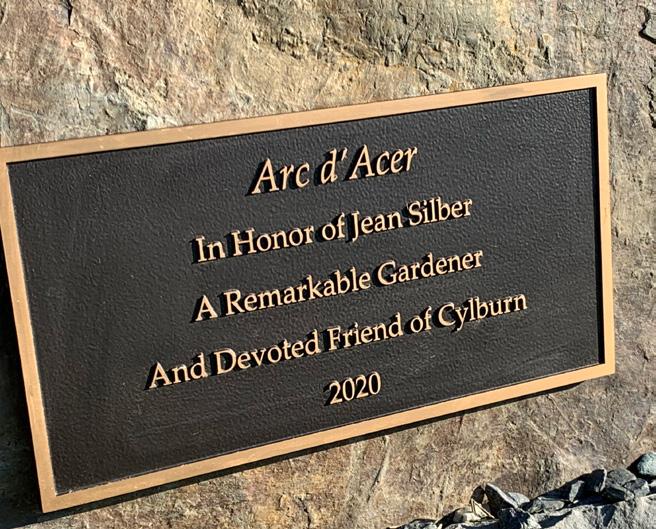
4 minute read
ARC D’ACER
Photo courtesy of Alan Gilbert
A TRIBUTE TO JEAN SILBER
SEEDING STONES
As a gateway into the maple collection, this arrangement of stones was inspired by winged maple fruit known as a “samara.” With a form meant to resemble an abstracted wing and seed, the sculpture can be viewed from many angles where it takes on different interpretations and even uses. In a landscape void of durable climbing structures, the stone samara is meant to be explored. Whether contemplated, leaned on, laid on, sat against, and even climbed, this structure is meant to be experienced by Cylburn’s visitors young and old. The fieldstone boulder and diverse range of bluestone pays homage to the materiality of the adjacent Vollmer Center. The stone slabs are completely dry set utilizing only gravity and quality craftsmanship to ensure their permanent stasis. The layered effect of the stone configuration took inspiration from the stratified nature of Piedmont outcroppings. Exposing these layers to the elements, similar to a natural outcropping, will lead to a very distant evolution into something new.
The juxtaposition of geologic time, arboreal time, and the human lifespan is meaningful fodder for contemplation on this site. It is our hope that one day beyond our period of influence, a hybridized maple seedling swirls down from towering heights to the shaded stones below. Finding no chance of survival in the arboretum’s sea of lawn, may that seedling grow here within the moss and duff filled crevices of this very installation. What could be more appropriate for an arboretum? What could be more fitting for a tribute to Jean Silber.
PLANTING HEAT TOLERANT SUGAR MAPLES
Balancing the arboretum’s historic precedent of library row plantings and the need to develop a future grovelike space, the Silber Maple Planting was conceived. As an arboretum, Cylburn is a collection of trees to trial, educate, and inspire. Some trees even have the ability to inspire hope. The act of planting a tree is an act of hope for the future: the future of our City, our region, and the climate to be. Sugar maples are plagued with shorter lives than lived in decades and climates of the past. As our city grows warmer, the vibrant reds and oranges of our biggest sugar maples are declining years before their full life expectancy. It is with this in mind that Cylburn has curated this planting.
Proceeding from the highest grade to the lower are four heat- and drought-tolerant sugar maple subspecies and cultivars. The first tree is A. saccharum subsp. floridium— the Southern Sugar Maple. The second maple is A. saccharum ‘Flashfire.’ This sugar maple is a recent industry introduction from the seed selection of the Caddo Mountain in Oklahoma. Our third maple is ‘Legacy,’ which is known for its reliability throughout the nursery industry’s South Eastern growers. Lastly, we have the ‘Fall Fiesta’ sugar maple. After canvassing local growers, ‘Fall Fiesta’ rose to the top for its performance in the natural experiment occurring in nursery blocks.
These trees, while small now, will grow to inspire us with their fabulous fall colors. These maples will teach us about the future of planting sugar maples in the Mid-Atlantic. And most of all, they will make us think of our friend and supporter Jean Silber.
DESIGN AND CONSTRUCTION

No stone goes unturned: Adam Fisher, right, principal, Pescatore Stone, and assistant mason, Eamon Espey, maneuver the stone that will form the samara in place.
When Paul Silber approached Nell Strachan, chair of the Landscape Committee, about creating a tribute to his mother, Jean, Nell was ecstatic. What would be appropriate for someone who had contributed to the Arboretum in so many ways?

Together with Paul and Nell, Brent Figlestahler (Fig) head gardener, and Patricia Foster, executive director, walked the grounds many times, looking for the right location. Designing the tribute fell to Fig and what you will see today is both a tribute to Jean and her love of trees and an example of Fig’s inspiration: a grove of sugar maples circling an outcropping of stone that resembles the maple seed, the samara. Arc d’Acer is located behind the Vollmer Center which offers a commanding view of the installation.

A TRUE FRIEND OF THE ARBORETUM

JEAN SILBER was born and raised in Syracuse, New York, and came to Baltimore to attend Goucher College. She and Sidney married in 1955, and raised three children together—Paul, Doug and Janet. The Silbers built their house on Woodland Drive in Lutherville in 1959 and Jean lived there until after Sidney’s death in 2013, establishing their fabulous garden which they generously shared with others who visited individually or as part of a tour group.
Jean and Sidney’s philanthropy has benefited many Baltimore organizations and institutions. Much of their sculpture and art collections have been donated to the Baltimore Museum of Art and Goucher. An education building on the Parks and People Foundation campus was made possible by their support (and bears their names). Stalwart members of the Horticultural Society of Maryland, Jean served on the Board for many years, and has also served on the boards of the Baltimore Museum of Art and the Enoch Pratt Library.
Jean’s signature support of Cylburn has benefited and enhanced almost every facet of the work of the Friends group, and her cheerful enthusiasm for everything, her frequent donations of special plants, her encyclopedic knowledge of plants and how to garden, and most importantly, being instrumental in the creation of the Cylburn Garden Endowment Fund, have all left her special mark on the Arboretum.








